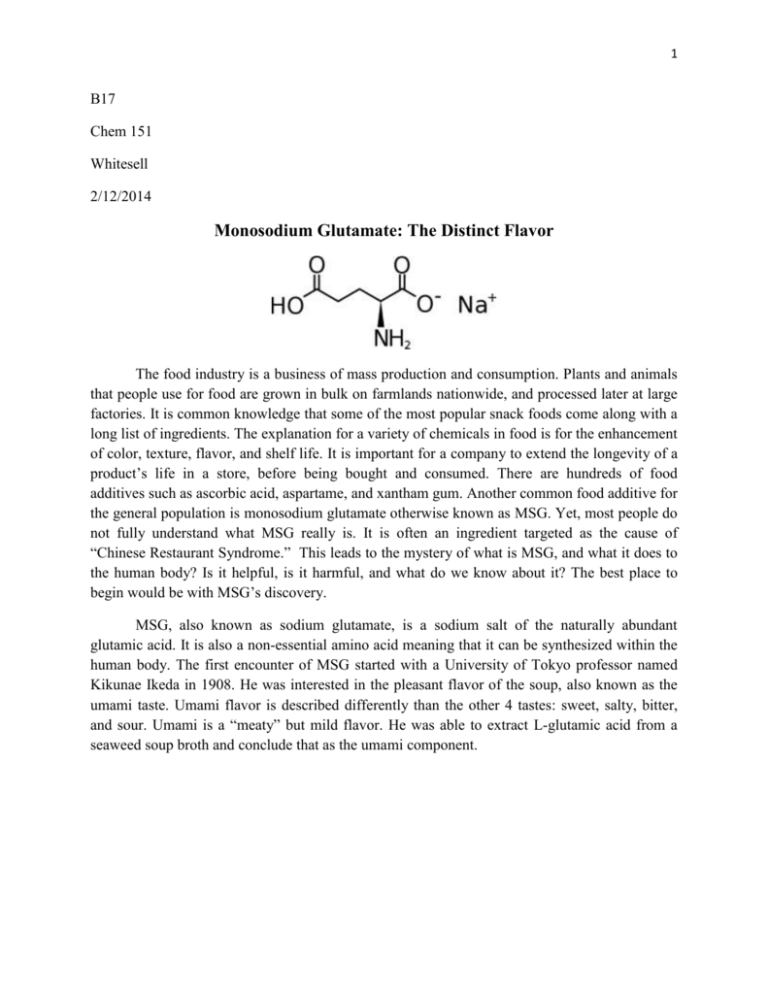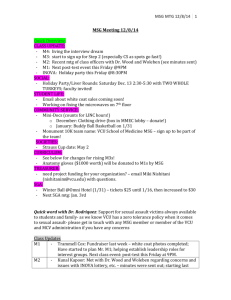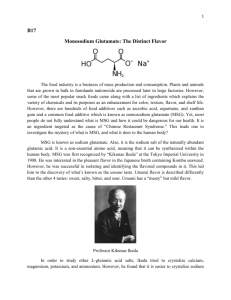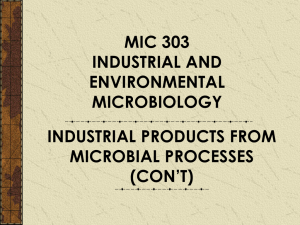B17
advertisement

1 B17 Chem 151 Whitesell 2/12/2014 Monosodium Glutamate: The Distinct Flavor The food industry is a business of mass production and consumption. Plants and animals that people use for food are grown in bulk on farmlands nationwide, and processed later at large factories. It is common knowledge that some of the most popular snack foods come along with a long list of ingredients. The explanation for a variety of chemicals in food is for the enhancement of color, texture, flavor, and shelf life. It is important for a company to extend the longevity of a product’s life in a store, before being bought and consumed. There are hundreds of food additives such as ascorbic acid, aspartame, and xantham gum. Another common food additive for the general population is monosodium glutamate otherwise known as MSG. Yet, most people do not fully understand what MSG really is. It is often an ingredient targeted as the cause of “Chinese Restaurant Syndrome.” This leads to the mystery of what is MSG, and what it does to the human body? Is it helpful, is it harmful, and what do we know about it? The best place to begin would be with MSG’s discovery. MSG, also known as sodium glutamate, is a sodium salt of the naturally abundant glutamic acid. It is also a non-essential amino acid meaning that it can be synthesized within the human body. The first encounter of MSG started with a University of Tokyo professor named Kikunae Ikeda in 1908. He was interested in the pleasant flavor of the soup, also known as the umami taste. Umami flavor is described differently than the other 4 tastes: sweet, salty, bitter, and sour. Umami is a “meaty” but mild flavor. He was able to extract L-glutamic acid from a seaweed soup broth and conclude that as the umami component. 2 Professor Kikunae Ikeda In an attempt to study other L-glutamic acid salts, Ikeda tried calcium, magnesium, potassium, and ammonium. He settled with sodium because it was the most soluble, easiest to crystalize, and best tasting. Ikeda then went on to patent and start producing MSG. With help from Ikeda, Ajinomoto was founded by Saburosuke and Chuji Suzuki in 1909 to produce MSG. Today, industrial manufacturers produce MSG as a flavor enhancer because it balances the overall taste of products. Ajinomoto USA has also formed, and to this day they still contribute in worldwide MSG production. Today, MSG is produced from the fermentation of starch, sugar beets, sugar cane, or molasses. The process was discovered back in the early 1950s when E.coli was observed to excrete amino acids, and yield of L-glutamic acid could be improved through the addition of ammonium salts. From that information, it was not long until Cornynebacterium glutamicum formed strictly (S)-glutamic acid, MSG, from ammonia and carbohydrates in vegetables [1]. The reaction is as follows: C12H22O11 (carbohydrate) + 3O2 + 2NH3 2C5H9O4N (glutamic acid) + 2CO2 + 5H2O The yield of (S)-glutamic acid in the culture is also influenced by its ability to escape the plant cell membrane. In high levels of biotin, a vitamin for cell growth, the cell membrane prevents the passage of glutamate. Both beets and molasses are high in biotin, which means they were not used until biotin inhibiting agents were discovered [1]. The nitrogen source is added to the culture through ammonium salts, urea, or pure ammonia gas. Ammonia gas is preferred because of its ability to maintain the pH at physiological levels. The fermentation process is aerobic, and thus uses oxygen. Keeping control of the temperature and oxygen levels, the fermentation runs about 35-45 hours. At the end, the fermented broth is centrifuged to remove any solids, and the supernatant is kept for further purification. The broth has its pH adjusted to 3.2, to reach the isoelectric point of glutamic acid. The isoelectric point is simply the pH where the amino acid has no electrical charge. Then crystallization is induced with seed crystals to get the resulting (S)-glutamic acid. Sodium then can be added to keep the salt neutralized. The advantage of this method is that the yield is around 60%, and it only produces the desired (S) 3 enantiomer of glutamic acid. The (R) enantiomer is not desired because it is tasteless. MSG powder will be white and odorless, and dissociates into glutamate and sodium in water. The molecular composition of MSG is C5H8NO4Na with a molar mass of 169.111 g/mol. The solubility in water is 74 g/100mL. As a flavor, MSG also enhances other taste-active compounds when combined with meat, fish, and vegetables. For example, this effect is seen in MSG reacting with disodium inosinate and disodium guanylate. The substances are tasteless in the absence of MSG, but upon its addition MSG will produce a flavor 6-8 times stronger than expected [1]. It will improve the taste of most food, but excessive amounts will make food unpleasant. MSG has also been used to help reduce the intake of sodium chloride. It is capable of improving flavors even if the salt chloride content has been reduced up to 30% of a standard amount. MSG from manufacturers Ajinomoto The most controversial subject about MSG has been whether or not it is safe as a food additive. The “Chinese Restaurant Syndrome” was created when many people described several unpleasant symptoms after consuming take out Chinese food. These include numbness, chest pain, headache, nausea, and drowsiness. Yet, the amount of MSG necessary to lethally kill a person is around 15-18 g/kg. This is a large amount, and would not be consumed accidentally by any normal human. In 1959, the U.S. FDA labeled MSG as “Generally Recognized as Safe” (GRAS). However, there is a small group of people that appear to have an MSG allergy when exposed to 3 g in the absence of food. The studies on MSG have not indicated any threat from MSG, but testimonies still report the adverse effects of it. As mentioned, MSG brought forth the term “Chinese Restaurant Syndrome”. This was studied by Dr. Russell Blaylock, who determined that MSG is an excitotoxin. An excitotoxin is a chemical that causes a brain cell to become overstimulated. As a result, an influx of calcium ions will go into the post synaptic cell. The high levels of Ca2+ will activate many cellular degradation processes eventually leading to the cell death [3]. This gives MSG the potential to increase permanent damage to the brain and nervous system. Neurological diseases such as Alzheimer’s, Parkinson’s, and Lou Gehrig’s also 4 have a higher reported chance [4]. The FDA has stated that the function of glutamate receptors have been linked with neurological diseases in laboratory animals [4]. Glutamate receptors are located in neuronal cells, with most of them residing in the brain. Glutamate is used as a neurotransmitter responsible for the excitation of neurons. These processes are important for neural communication, memory formation, and learning [5]. Glutamate receptors are also found in heart tissue and in the heart’s electrical conduction system [2]. Yet, the FDA dismisses the fact that consuming MSG will contribute to any neurological problems through lack of evidence. There is also the theory of experiencing lower health with a high level of MSG in the diet. People affected by MSG have also been linked to obesity, eye damage, headaches, fatigue, and depression. The reason that these food companies do not remove MSG from their products is for the sake of the sales. They need to keep MSG so products are not compromised, and to avoid getting caught they have tried relabeling MSG. They will hide it by using obscure ingredients that contain MSG instead. Another view is that MSG is not the culprit, but rather the high fat content of food that it is in. People also argue that all substances are poisons depending on the amount that a person ingests. This proves that table salt is no more dangerous than MSG at small levels; however, it is very toxic at high levels. Finally, people also question whether there is a difference between natural L-glutamic acid and processed L-glutamate. They are technically the same, except that L-glutamic acid produced commercially is subject to impurities such as D-glutamic acid, and pyroglutamic acid. These impurities might also be part of the reason that MSG is harmful to people. Therefore, the history of MSG is a continuous debate of whether food companies rely on it too much for flavor. There is the side arguing that MSG has been the problem to many medical conditions. Then, there is the other side that concludes no finite evidence of MSG being linked to headaches, numbness, chest pain, nausea, and heart problems. However, the FDA has confirmed that some people are allergic to it. It has also yet to be determined why natural glutamate in cheese produces no side effects, whereas commercially produced MSG does. The truth appears to be conclusive that MSG is generally harmless, but should be consumed in moderation. That is easier said than done, because when at the store it is surprising how many items contain MSG or some variant within them. 5 Works Cited [1]Ault, Addison. "The Monosodium Glutamate Story: The Commercial Production of MSG and Other Amino Acids." Journal of Chemical Education 81.3 (2004): 347-55. Print. [2]Blaylock, Russell L. "Sudden Cardiac Death and Food Excitotoxin Additives by Russell L. Blaylock, MD." Sudden Cardiac Death and Food Excitotoxin Additives by Russell L. Blaylock, MD. N.p., n.d. Web. 13 Feb. 2014. [3]Dubinsky JM (February 1993). "Intracellular calcium levels during the period of delayed excitotoxicity". J. Neurosci. 13 (2): 623–31 [4]Misner, Bill. "MONOSODIUM GLUTAMATE (MSG), GLUTAMIC ACID (Glutamate), GLUTAMINE REVIEW." (n.d.): n. pag. | Hammer Nutrition. Web. 12 Feb. 2014. [5]Olney, JW. "Excitotoxins in Foods." Neurotoxicology (1994): 535-44. Review Of: Excitotoxins: The Taste That Kills | American Nutrition Association. Web. 13 Feb. 2014.








